Hello, and welcome to this seoClarity webinar on the state of the enterprise SEO industry!
This is our annual report on the observations that we've made over the past year about the biggest changes and the biggest developments in SEO — particularly with Google search.
Those findings were combined with our proprietary data from our vast database of keywords, query research and all of our clients across the globe, to bring you the things that mattered most in 2020, and what we believe will matter most coming into 2021.
Use the hyperlinks to jump to each respective section of the agenda:
- Rapid Change in SERPs >
- Does Traditional Ranking Still Matter? >
- Addressing User Intent >
- Impact of Schema Markup >
- Answer Box Shakeups >
- How Much Do Images Matter? >
- Core Web Vitals >
- Google AI Updates >
You can also watch the webinar, here:
#1. Changes to the SERPs
New SERP Features Continue to Change Search
We've said it before: it's not your parents' SERP anymore. Looking back over the past two year ago — and certainly five or 10 years ago — the search engine results pages look very differently than they used to.
Just look at the evolution of the SERP for the keyword "hotels". Five years of change in 60 seconds!
As Google continues to experiment with new features, new ways of presenting results, new ways of getting the information and answers that users want and need, the SERPs continue to change — almost daily!
Let's take a look at some of those changes and how they've been occurring.

These are two very important numbers. Why? They represent two major findings that come from looking at our sample of over 6.3 million keywords globally.
That first number, 1200+, is the number of unique features that we found in Google SERPs.
Now, by feature, we mean anything from the big, visible things like an Answer Box, a featured snippet, the image carousel, People Also Ask, etc., down to the tiniest alterations that can appear in very specific queries.
All of these are unique features and they all take up space on the search page. They all change the way the page is presented to a user, so they're all important.
Last year, when we ran this analysis, we found just over 800 unique SERP features.
The 200 number is the amount of SERP features that we've found on more than 0.2% of keywords.
This means the vast majority of those 1200+ SERP features don't show up very often, and they only show up for very specific queries. Yet, there are a lot of updates that are present in the search results — some of which we'll see below — that SEOs need to pay attention to.
The Rise of the Zero-Click Search
The proliferation of zero-click searches caused concern for many SEOs, especially at the beginning of 2020.
What is a zero-click search? Just like the name implies, these are searches and the respective search results where the user doesn't click on anything.
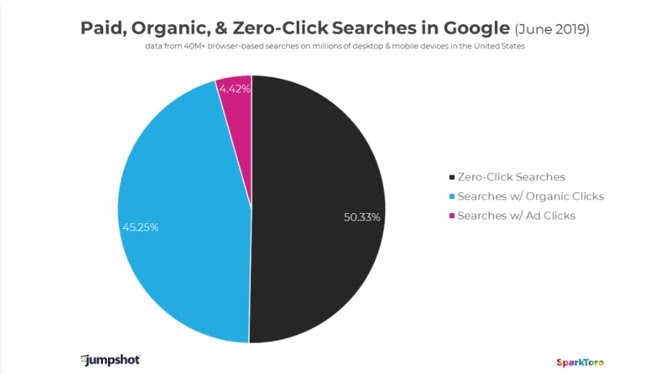 (Image Source: SparkToro)
(Image Source: SparkToro)
When Rand Fishkin put out this data in 2019, it claimed that a little over half of all of the searches resulted in zero clicks. Naturally, this sparked concern for those who work in organic search, and spawned another bit of speculation that "SEO is dead."
Let's dig a little deeper into this.
First of all, we need to separate out true zero click SERPs from other kinds of clicks that simply aren't going to our third-party websites.
This is an example of a true zero click search result:
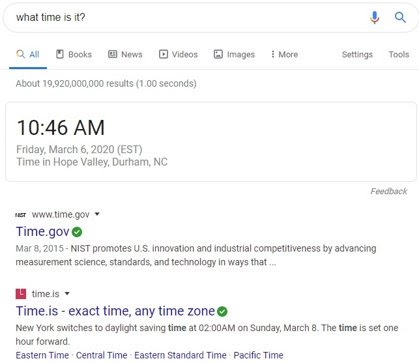 (A zero-click search offers users the information they seek directly on the SERP.)
(A zero-click search offers users the information they seek directly on the SERP.)
The query for this search is "what time is it?" and as you can see, Google shows the time. That's all the user wanted to know — it's unlikely that they'd click on anything else for that query.
However, many things that were showing up in those statistics as zero-click searches were simply clicks that we couldn't track or evaluate with the tools that were available at the time.
A great deal of those are clicks that go through to Google properties — pages that have a google.com domain name (e.g. maps.google.com) or those domains that are owned by Google, but not google.com specifically (e.g. gmail.com).
These are still clicks.
Things are getting clicked on in a search result. They just happen to be going to Google properties.
Now, this still sounds like bad news for organic search.
When you look at the search results themselves and how they've changed, you can see that in some cases the SERPs seem to compete with us just by the way they're presented.
Here's a search from October 2016, for "hotels":
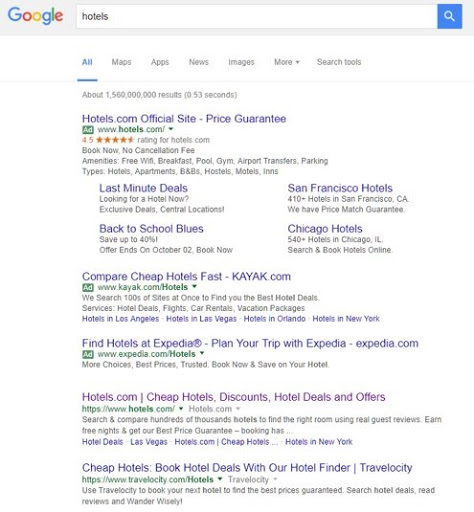 (SERP results for the keyword "hotels" from 2016.)
(SERP results for the keyword "hotels" from 2016.)
You can see three ads show at the top of the page, and those have been around for a long time. They're a feature that we've been taking into our account for a while now.
Do note that this search was made on desktop, but the first organic web result is on the first fold. That is, no scrolling is required to see that listing.
Let's look at the same search in November of 2020:
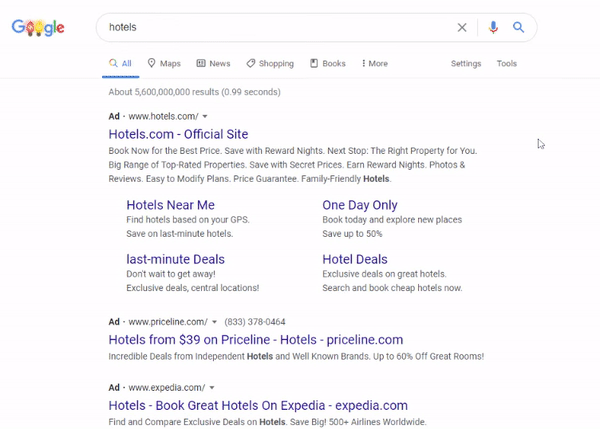 (The various SERP features push the first organic result down the page.)
(The various SERP features push the first organic result down the page.)
Look at the change!
We see this big map result between the ads and the first organic result. Now that's not only pushed the first organic result further down the page, it actually pushed it off the first fold to the second fold.
That means a user now would have to physically scroll down the page to see that first organic result.
Visibility here becomes a major factor in the SERPs.
However, the overall news is not that bad. Our analysis of over 500 sites looking at over 19 billion clicks over the span of a year showed that nearly a third of the traffic to sites is still driven by organic search.
The Takeaway: SEO is still the most important source of traffic to almost all websites.
#2. Traditional Rank Reporting is Outdated
Let's turn now to the question coming out of that: rankings. If the competition of search features and the many changes to the SERPs continue to increase, then is traditional ranking out the window?
Does it matter where your listing stands in terms of the 10 blue links? Let's dive in.
The competition for visibility on a SERP doesn't just come from the search features, which push elements further and further down the page, but actually the nature of organic search results themselves.
Some of those 1200+ features that we talked about earlier are being incorporated more and more into search results, especially as sites are taking advantage of the schema markup.
Note: We'll talk more about schema down below.
Let's take a look at schema implementation in action. Here is a search result for a specific hotel — it's a pretty traditional organic search result with the blue link, the URL, and the meta description. It does include an early iteration of site links, but other than that, it's standard.

Now, look at another search listing for the same query, this time from TripAdvisor. Not only does it have a lot more information (thanks to schema) but it also takes up more vertical space.

Remember that as a search listing acquires more vertical space, it pushes other search results further down the page. That's a little bit more distance that the user has to go to find those other results.
Finally, we have an example from booking.com that uses the FAQ schema to increase the search visibility. Look at how much space it takes up!
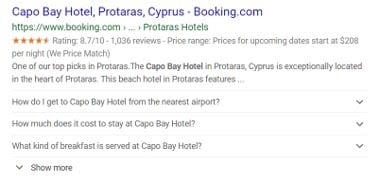
Imagine that you're the number second or third result below that. The users are really going to have to put in an effort to find your search result — especially on mobile!
The New Way to Track Rankings
Since the way we define rankings has changed (i.e. to focus more on overall search visibility more than rank position) the way we track these rankings has to change, too.
This is where a feature like seoClarity's Visibility Share becomes incredibly useful — it gives you the metrics that tell you your true position in search and reveal your true competition.
Let's look at just a few of those metrics that Visibility Share would show you, and how it gives you something beyond your traditional ranking reports.
Find Your Real SERP Competitors
What we have to take into account these days is that our competitors are no longer just other businesses in our vertical that are also trying to rank in the search results. The competition is the search results features themselves.
Look at the SERP competitors for this particular domain:
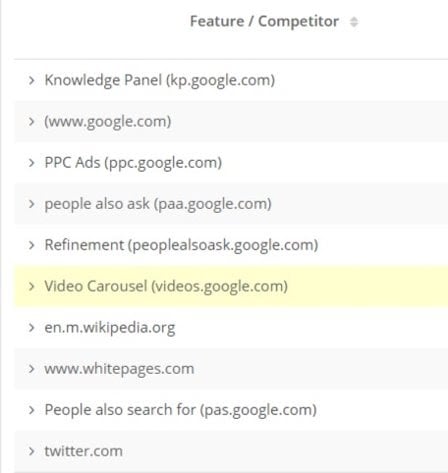 (SERP competition now includes more than just other businesses' domains.)
(SERP competition now includes more than just other businesses' domains.)
Notice that Visibility Share shows this list not just as competitor at the top heading but also feature and competitor because search features are now competitors.
Look at the list of features that appear before we even get to the first organic web result: a knowledge panel, something from a google.com domain, ads, People Also Ask, a refinement box of the People Also Ask box, and video carousels.
Then, finally, we reach wikipedia.org as the first organic result. These are on the average, of course, but all of these elements show up on top of the organic results.
The Metrics that Matter
Another thing that Visibility Share gives us is what we call the metrics that matter. We can see things like our Visual Rank, which counts all of the features on the page.
So if you have an image carousel and a featured snippet, and then you're the first organic result, your visual rank is actually three, not one, because you have those two other features above your listing.
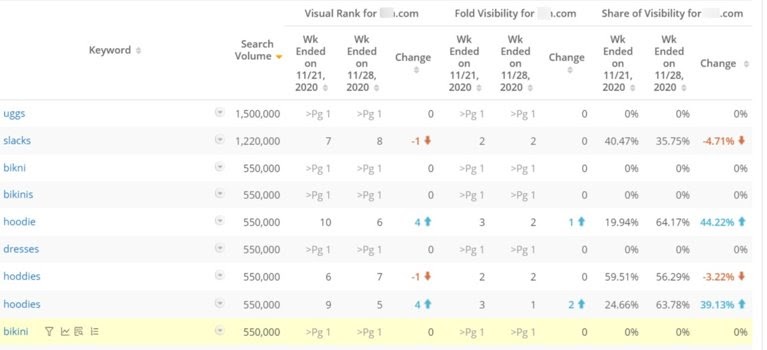 (A Visibility Share report in the seoClarity platform.)
(A Visibility Share report in the seoClarity platform.)
Another one is Fold Visibility, which shows us what fold we're in. In the example above, we see that for this particular domain, some of their keywords are showing up in the second fold. Those might be opportunities!
We want to think now in terms of folds, rather than pages (this is especially true for mobile). Are you showing up in that first fold?
If you're in the second fold, that's an opportunity where you might want to try up and move up to that first fold to earn more search visibility.
In fact, our statistics show that on the whole, when users are able to move up from the second fold to the first fold, CTR increases dramatically.
Finally, there's our proprietary Share of Visibility metric, which is a percentage that shows your exact visibility on the page. The higher the percentage, the more visible you are on that search results page.
This is a weighted metric that's much more useful for comparing with competitors and between keywords.
All of these are different ways to look at your rankings that we think are more relevant in 2020, and coming into 2021.
Strategic Response: Changing SERP Landscape
With all the changes to the SERPs, how should you strategize? Keep in mind these three actionable steps as we move into 2021:
- Shift your focus away from just traditional ranking reports alone.
- Don't panic about zero-click searches! Organic search still accounts for the most traffic.
- Include strategies to identify and prioritize opportunities to rank for specific search features, where it makes sense to do so.
The Takeaway: search visibility on the SERPs begins to matter more than traditional rank position.
#3. User Intent's Role in Search
The first big move toward search intent in recent years actually happened in 2019 with the introduction of BERT — a huge push toward natural language processing.
It gives Google the ability to better understand the relationship of words in a query and to better define what somebody actually means by their query. Take "stop words", for example.
These are small, short words that the search engine used to ignore, but now takes into account because those stop words can make a big difference in what the searcher actually means by their query.
That means that Google was (and is!) much more able to uncover user intent more accurately. Since its release, BERT has grown to now impact nearly all search queries.
As you plan and create your content, you'll want to keep in mind the underlying intent behind a keyword.
In the seoClarity platform, the keyword intent is shown in multiple places, but it's extremely valuable in Research Grid.
 (This particular search query has a transactional intent.)
(This particular search query has a transactional intent.)
For any given keyword in our database, we use artificial intelligence to analyze top ranking content for that particular query and pick up on the underlying keyword intent, and display that information in a summary box.
That way, you can match your content to the intent of the user to deliver the type of content you know they're searching for. Plus, it's not only important for the user, but important for Google as well.
Strategic Response: From Just Keywords to Intents and Topics
As Google develops, your strategy needs to follow suit. Keep in mind the following as you develop your content strategy for 2021:
- Realize that many keywords can have multiple intents. Create different content assets that meet all of the relevant intents.
- What Google puts on the SERP is a clue to the searcher intent. An Answer Box, for example, tends to appear when the query has an informational intent.
- Use keywords research as a basis for developing topical content strategies.
The Takeaway: targeting the correct intent is key to creating relevant content.
#4. Schema Markup Impact
Schema continues to be a growing area and has grown to become something that should be considered now a fundamental of SEO.
As schema is successfully implemented on the whole across sites, there tends to be an increase in CTR. It's important to emphasize that schema markup is not a ranking factor.
However, it's benefits can't be ignored: it improves your appearance on the SERPs, it increases the amount of real estate you take up on the search page, and it enhances your search listing with visual elements.
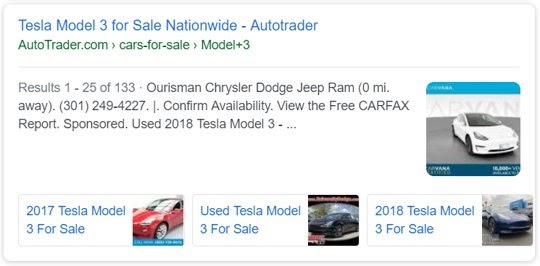 (Schema give this result an enhanced appearance with imagery.)
(Schema give this result an enhanced appearance with imagery.)
Making your search results more attractive also makes them more clickable, as we noted that implementing schema tends to increase CTR.
The big news in schema has been for a while now the implementation of the FAQ schema because it adds so much value in the search result.
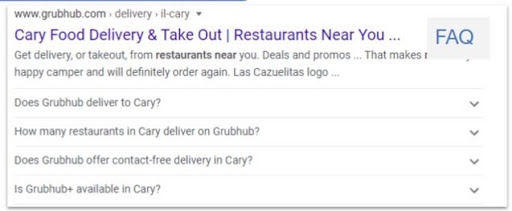 (The FAQ schema greatly increases a listings vertical pixel space.)
(The FAQ schema greatly increases a listings vertical pixel space.)
Not only do the FAQs take up more space, which means you're pushing the competition even lower down the page if they're below you, but they also have the ability to directly answer what a user is looking. And that means: happy users!
Schema Implementation at Scale
To help SEOs build and deploy schema, we introduced schema.dev — our suite of free tools that you can use to help you implement schema more simply.
Schema Builder — which recently won the top prize for Best SEO Software Tool at the US Search Awards — is a free tool that lets you paint right on the content of a page to create the applicable code. You don't even have to know how to build code!
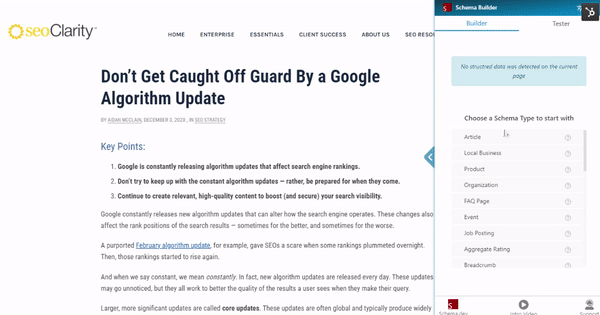
(Create a schema code with a point-and-click interface.)
Schema Tester allows you to test the validity of your schema code on any page of your site; and soon to come: Schema Deployer. This will help enterprises deploy schema the massive scale required.
Strategic Response: Schema and the FAQ Markup
Be sure to familiarize yourself to the benefits of schema, and the process in which it's implemented.
- Realize that FAQ schema not only increases search visibility, but can also help to reduce sales resistance.
- Be aware that Google is turning a wary eye on over-optimizing with schema. It recently limited FAQ schema results to three per page.
The Takeaway: there is a large opportunity to gain search visibility with schema.
#5. Understanding the Answer Box
In our earlier research on the Answer Box, we noted the intense fluctuations in the presence of the search feature, but now the Answer Box seems to have settled down and presents itself for 16-20% of all the keywords that we monitor.
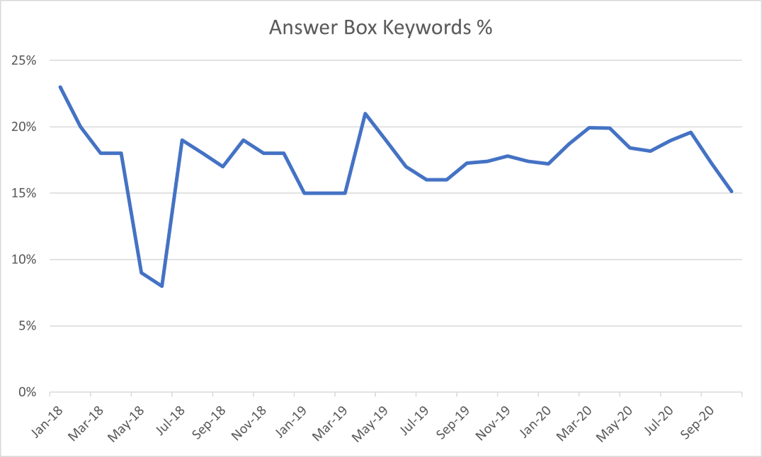
(The Answer Box has seen major fluctuations in years past.)
They're a lot more steady now, but there's still some up and down, so don't be surprised if you see Answer Boxes coming and going for queries. Just because it's gone one day doesn't mean it's gone forever.
The industry also makes a big difference for the Answer Box.
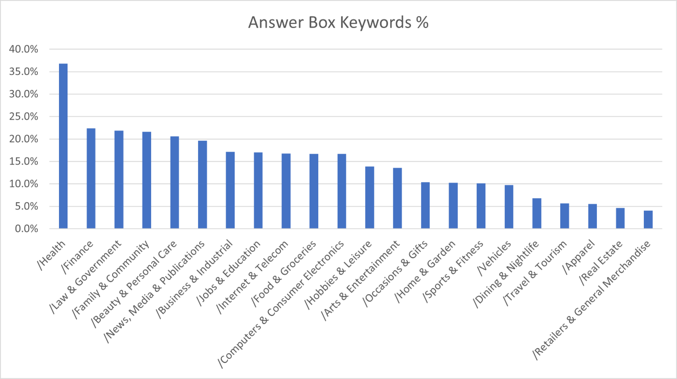 (Queries related to the health industry see the most Answer Boxes on the SERPs.)
(Queries related to the health industry see the most Answer Boxes on the SERPs.)
Health, finance, law and government, family, and community, etc. are the verticals where you'll find a lot more Answer Boxes on the SERPs.
seoClarity's Research Grid Answer Box feature shows you the opportunities for securing the Answer Box, which may lend itself well to your content strategy.
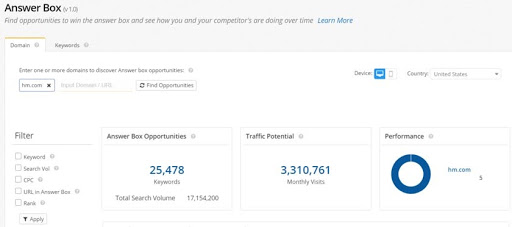 (Discover Answer Box opportunities and see how your competitors are doing over time.)
(Discover Answer Box opportunities and see how your competitors are doing over time.)
Strategic Response: Answer Boxes
If you integrate the Answer Box approach into your strategy, it's important to have a strategic goal to be working toward.
- Ask yourself the following questions to determine if tackling the Answer Box is the right move for you:
- Is an Answer Box held by a competitor hurting us?
- Can we create an Answer Box situation that is likely to get clicked?
- If it won't get clicks, is the brand presence enough to make it worthwhile?
- If you do go after the Answer Box, be sure to create content that clearly answers prospective questions.
The Takeaway: Answer Box opportunities may be better suited for certain industries.
#6. The Rise of Images
Images continue to be a huge part of the SERPs over the years. Over the course of 2020, around 70% of all keyword searches included image results on the SERPs. 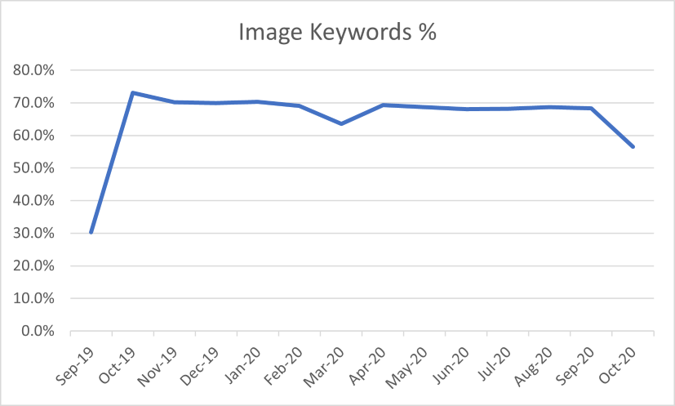
(The percentage of keywords that show images on the SERPs.)
With the high frequency of images appearing on the SERPs, you may be ready to optimize for images straight away and tackle that opportunity.
However, at the same time, images only account for about 12% of the impressions in these results.
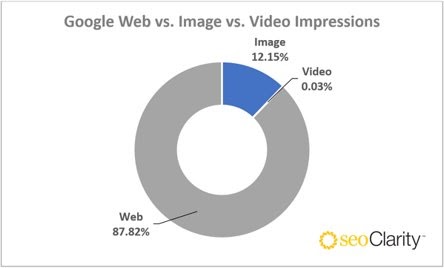
(Images earn a small percentage of impressions.)
When we look at through to clicks, it's almost none existent!
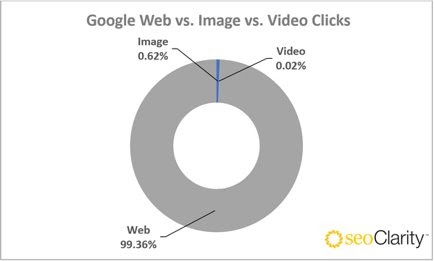 (Images earn just over half a percent in clicks.)
(Images earn just over half a percent in clicks.)
The bottom line here is that images can drive traffic to your site, but it's not a given.
Strategic Response: Image Search
Images may present themselves frequently for search queries, but that doesn't mean it's the right optimization tactic for everyone.
- Ask if the image search is worthwhile for your industry and/or the way that your prospects search.
- Other reasons why optimizing images may make sense for you:
- Google's increased focus on image monetization.
- In-stock, price, and buy options are being tested.
- Mobile image carousels.
- Mobile SERP image snippet.
The Takeaway: images aren't a guarantee for site traffic.
#7. Core Web Vitals and Page Experience
Let's talk about the two big search ranking announcements made by Google this year.
It's such a rare occasion when Google actually comes out and announces a specific change in their search algorithm. When those announcements come out, we really want to pay attention to those!
In early may of 2020, Google announced the concept of web vitals on their Chromium Blog.
This is a new set of metrics that Google said they're going to prioritize. None of the metrics have to do with the search result itself, but with the click and the page. What is the user's experience on your site once they get there?
Why does Google care about that?
People judge a search engine by the quality of what they get after they click through.
Google wants to give users the experience that they want to have on web pages, particularly on mobile.
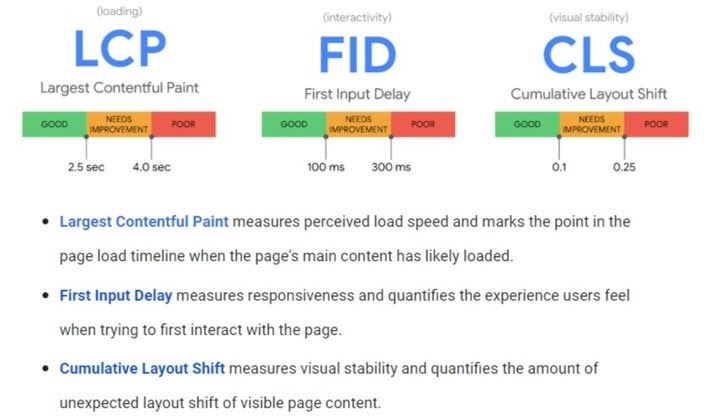
(Google's core web vitals all pertain to page speed.)
Out of those web vitals, Google named these three brand new metrics as the core web vitals — meaning the things that matter most to them.
They all have to do with page speed, and particularly how that page speed is experienced in ways that matter to the user.
Here are examples of what these metrics relate to:
- When does the first main content appear in a way that the user can actually begin to read it or view it?
- When can the user begin to interact with things on the page without them jumping or moving around?
- When does all that jumping around stop, so the page becomes something static that the user can manipulate?
These are all things that are going to become part of an upcoming algorithmic update, which is going to utilize what Google calls the page experience signals.
So in addition to those core with vitals that have to do with how content loads, how a page loads, and how the user experiences that content, Google also takes into account:
- Is the page mobile friendly?
- Is it safe and secure?
- Does it have needless pop-ups that distract the user?
All of these together are called the page experience signals, and Google then announced that those are going to become part of the algorithm. In 2021, they will become an actual measurement that Google will use to affect search rankings.
seoClarity's Page Speed Analysis feature has now incorporated those core web vitals, so you don't need to go anywhere else for that data. This is another way in which seoClarity becomes your one-stop for all of the vital SEO information that you need.

Strategic Response: Core Web Vitals
Google has announced that the roll out will occur in May 2021, which gives us plenty of time, but keep the following in mind:
- Make plans now for any needed speed improvements, especially for mobile.
- It's not likely to be a top ranking factor, but it could act as a decisive tie-breaker when there is still competition on the SERPs.
The Takeaway: the user experience remains a critical factor for search.
#8. The Search On AI Updates
Google announced "Search On" in a blog post in October 2020. There were a number of updates announced, but let's cover those that are the most important from an SEO standpoint.
But first, some overall points about the updates:
- A collection of AI-driven search updates.
- Applying advanced AI language recognition to more queries.
- Implementing new ways to rank sections of content.
And some more basic facts to know about these updates:
- Most changes will affect 7-10% of queries (but one hits 100%!)
- Some of the updates are already in effect, some are rolling out, and others will be released in late 2020 to early 2021.
BERT Now Processes (Almost) 100% of Queries
BERT now processes almost a hundred percent of the queries on Google. What does that mean for searches?
Let's look at an example …
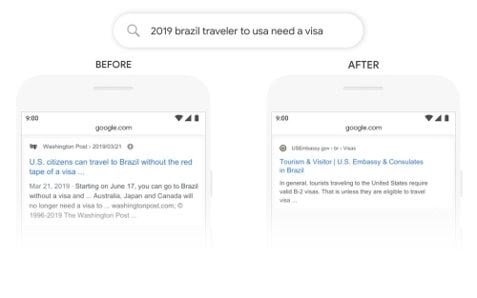 (BERT in action, before and after.)
(BERT in action, before and after.)
The natural language processing allows for a better understanding of queries through context, as well as their search intent.
In the example above, before BERT, Google would have just shown a general information page about a basic piece of information.
Now, Google can dig down and find a page that exactly answers that question. It's specific to Brazil, specific to 2019, specific to a USA visa.
What Are the Implications of BERT?
You can't necessarily optimize for BERT, but you should see the potential for more traffic from more long tail and obscure queries. The one thing to do here continue producing content, and continue your wide coverage of topics.
As always, have comprehensive, well-written, well-structured content that's clear and that matches the users' intent.
Passages
Passages is the ability to rank an individual passage — an individual section, a paragraph, a group of paragraphs — from a page, not just a whole page.
Google can now pull out, in response to specific queries, specific sections somewhere on the page that answer a query.
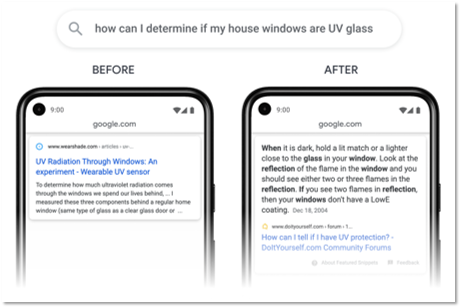
(Passages pulls out the precise information that answers a user's query.)
This may cause some concern, just like Feature Snippets did when they first came out. Some SEOs fear that if the direct answer is given right on the SERPs, no user will click through.
But, as we saw with Featured Snippets, they will drive traffic. Yes, users want to get that specific answer, but then there's more they want to know. If you're the one appearing there, then you could very likely be the listing they click on so they can learn more.
Now, this is not an opportunity, however, to rank your page for a topic and get these passages to rank.
What Google says that they're using this for is to seek out those pages on the web that formerly weren't ranking for anything, but maybe have that one paragraph that's super useful to a very specific set of queries.
This means that in some cases, your content that wasn't ranking before may start to show up as passage results.
Google says that this will impact 7% of searches, and they're rolling it out gradually.
What Are the Implications of Passages?
Just like BERT, you can't optimize for passages, but you can ensure that your content covers topics comprehensively, structure your content well (i.e. include appropriate headings, subheadings, etc.), and add more semantically relevant words to your content.
For the latter point, utilize Content Fusion, our AI-driven content writer that presents you with a list of must-use topics to cover in your content. It allows you to create the most authoritative, relevant content at a powerful scale.
Subtopics
Subtopics are Google's attempt to diversify the search results more where that's warranted.
This is going to be mostly for head term-type searches where Google can't always be sure of the exact underlying intent or the specific thing a searcher might be looking for.
You can think of this like an advanced version of People Also Ask or Related Topics, where the search engine will present a more diverse range set of organic web results for a head term.
This is expected to roll out by the end of 2020.
What are the Implications of Subtopics?
You want to have more and more standalone content that covers specific topics. A main content hub page that covers the main topic well is still a great content approach, but then you need to build out those subtopics and keep those assets interlinked together.
This approach will prove to Google that you cover the topic comprehensively.
 (Cover all the subtopics of a main topic to demonstrate your knowledge on the subject.)
(Cover all the subtopics of a main topic to demonstrate your knowledge on the subject.)
The Takeaway: Google constantly innovates new ways to improve the user experience.
Embracing Search Experience Optimization
As we go into 2021, we emphasize what we always have at seoClarity: move your thinking from search engine optimization to search experience optimization.
This is the framework that we've built our entire platform around, and it's how we advise our clients on their journey to SEO success.
Much of the information covered in this webinar has to do with the experience of the end user: their experience on the SERPS, as well as their experience on your website pages.
Thinking about improving that experience in every possible way, and you'll be winning in 2021.






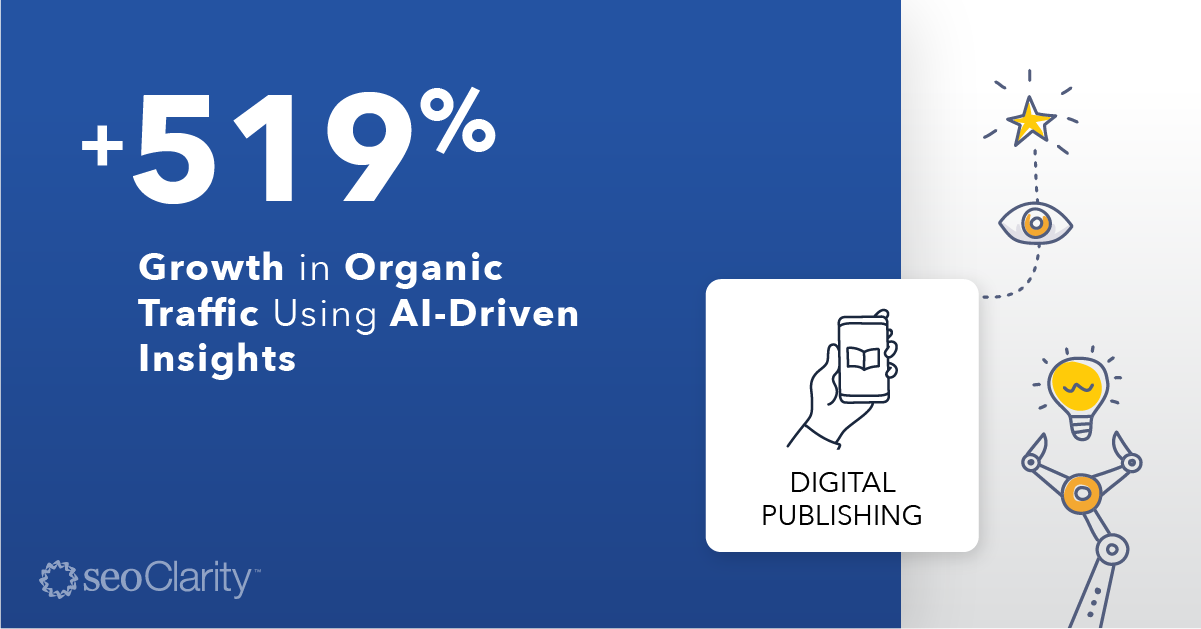
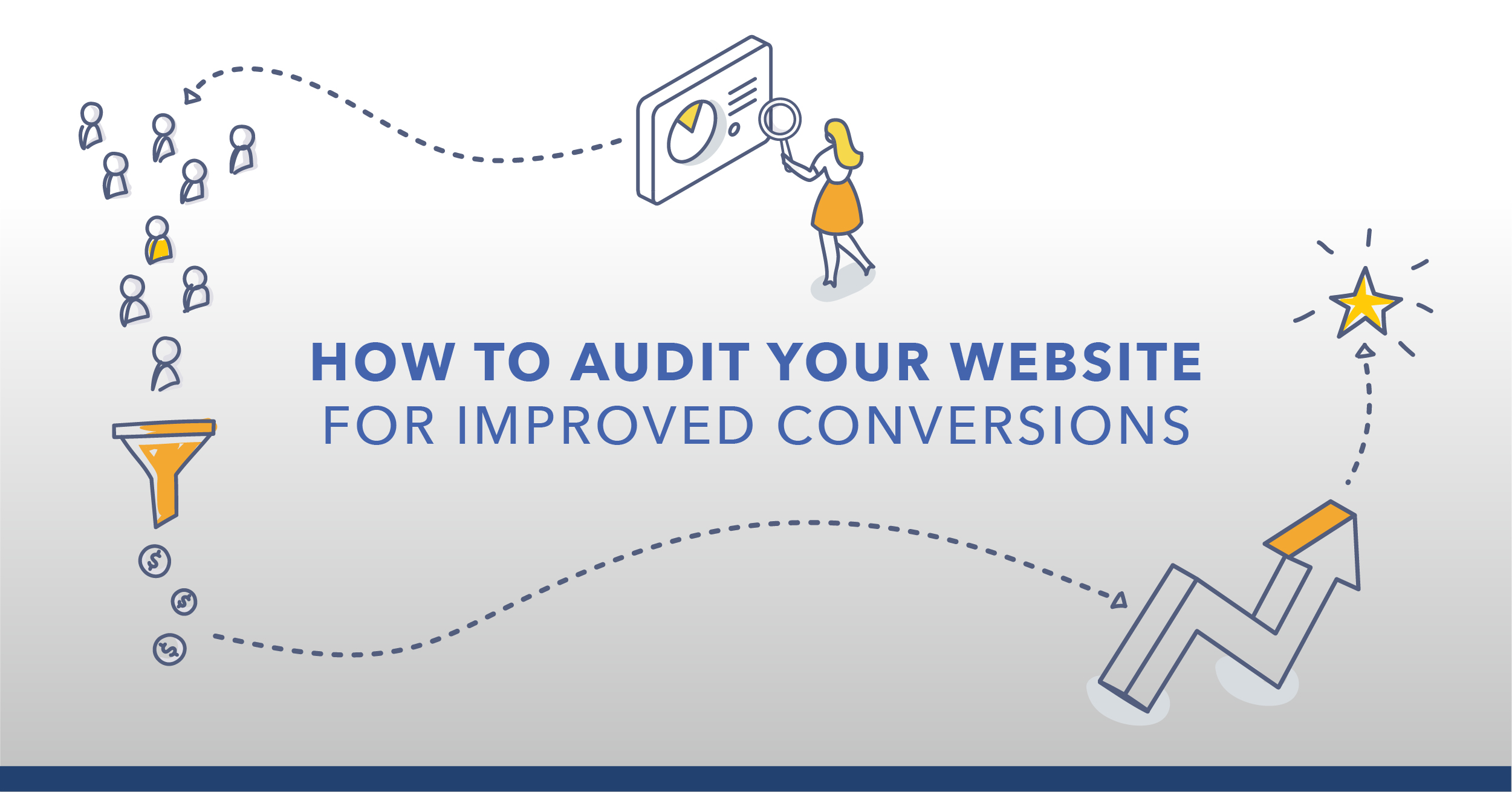
Comments
Currently, there are no comments. Be the first to post one!